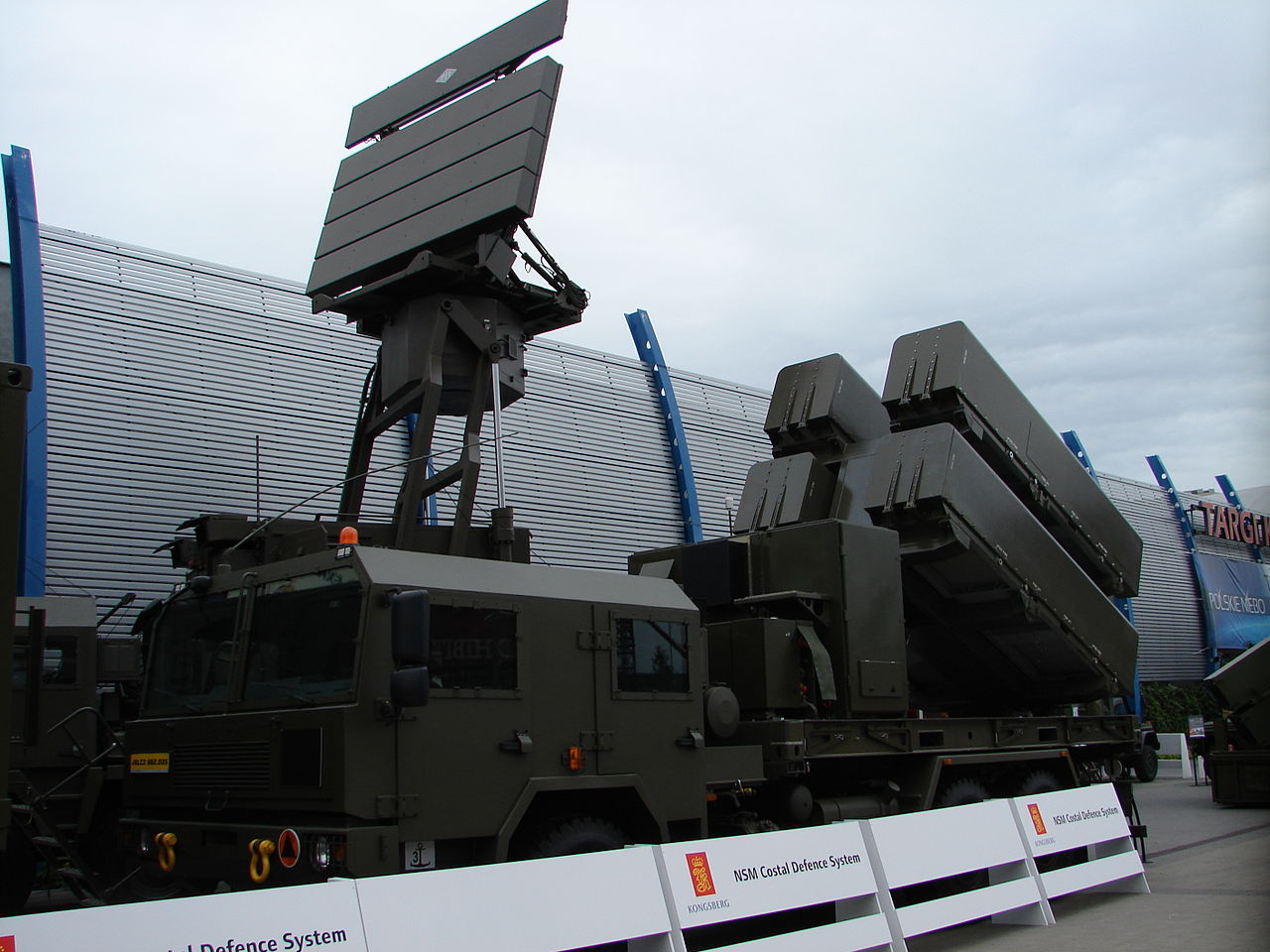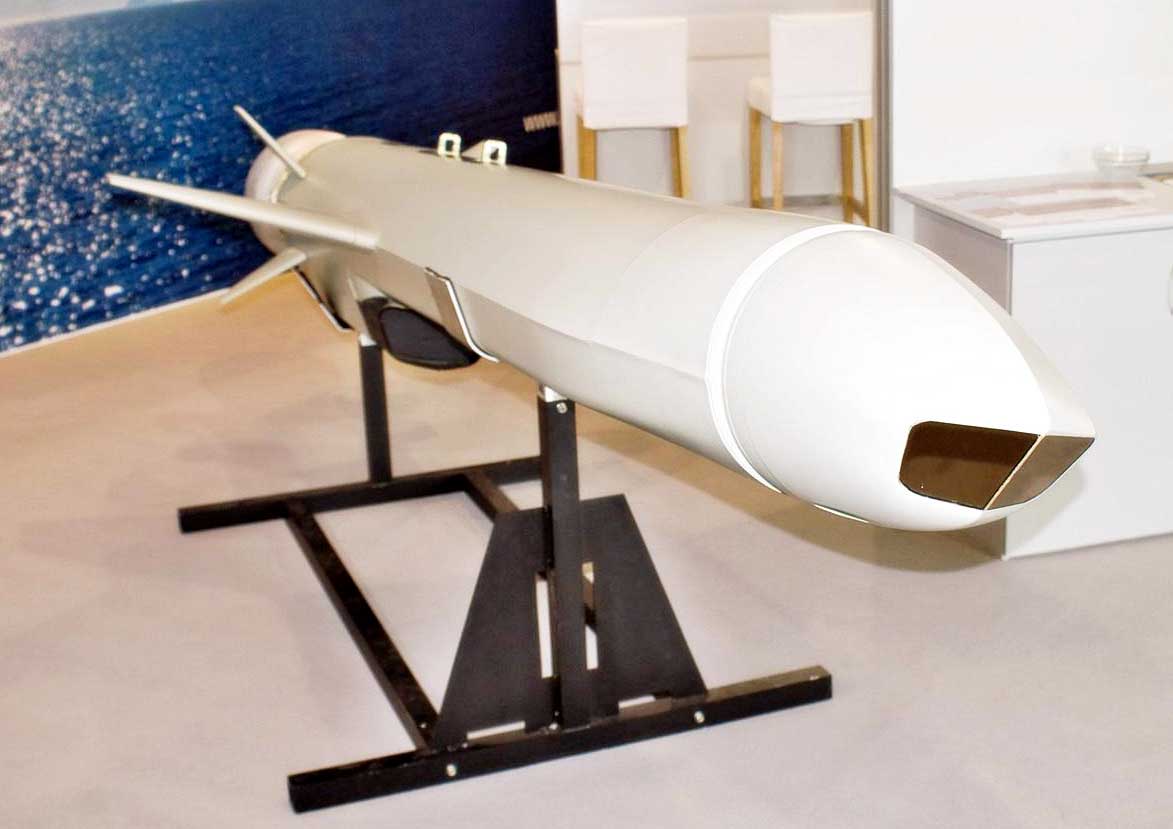Naval Strike Missle - The Naval Strike Missile (NSM) is an anti-ship and land attack missile developed by the Norwegian company Kongsberg Defense and Aerospace (KDA).
The original Norwegian name was Nytt sjømålsmissil (literally New Naval Missile, indicating that it was the successor to the Pguin missile). The trade name Naval Strike Missile was later adopted. According to Kongsberg the NSM/JSM has been selected by 2022 by Norway, Poland, Malaysia, Germany, the United States (as RGM-184), Japan, Romania, Canada, Australia and Spain.
Naval Strike Missle

The Royal Norwegian Navy has selected it for Fridtjof Nance-class frigates and Skjold-class patrol vessels. The NSM was selected by the Polish Navy in December 2008, which ordered fifty land-based missiles (including two for testing) in operations conducted in 2008 and 2011, with deliveries planned for 2013–2016.
Naval Strike Missile
On 10 October 2012, the Royal Norwegian Navy launched the NSM for the first time. The vessel in question was HNoMS Glimt, a Skjold class patrol boat.
On Wednesday, June 5, 2013, the Royal Norwegian Navy conducted the first firing test of an NSM missile carrying a live warhead at a target ship. The Oslo-class aircraft carrier HNoMS Trondheim is damaged and the gun is still operational.
In June 2013 Poland completed its Coastal Missile Division with 12 NSMs on Jelcz chassis and 23 vehicles (including 6 launchers, 2 TRS-15C radars, 6 fire control vehicles and 3 command vehicles).
In the end, the Beach Millions division was held by 12 runners each with 4 shots for a 48 total. In December 2014, Poland ordered a second batch of launchers and missiles to join the Naval Strike Missile Battalion.
Moskva Was Possibly Sunk By A Norwegian Missile
In late July 2014, the US Navy confirmed that the NSM would be tested aboard the USS Coronado (LCS-4) littoral combat ship.
In 2015 Kongsberg and Raytheon partnered to establish the NSM to incorporate the LCS as an air-to-air anti-ship missile.
As of May 2017, the Boeing RGM-84 Harpoon and Lockheed Martin LRASM have been phased out of the Navy's Competitive Over-the-Horizon Weapon System (OTH-WS), leaving the NSM.

As of 31 May 2018, the Navy designated the NSM as the OTH anti-ship destroyer of the LCS. An initial $14.8 million contract with Raytheon included Kongsberg-made "missiles loaded into metal launchers; and a single fire control unit," which would be procured for a dozen missiles; The cap contract value can rise to $847.6 million. Contractual options are used.
Naval Strike Missile Now Aboard Uss Mobile (lcs 26) > Naval Surface Force, U.s. Pacific Fleet > News
Fridtjof Nans successfully fired the NSM during SINKEX at RIMPAC 2014, touching the missile and firing according to design.
At the LIMA 2015 exhibition, Malaysia announced that the Naval Strike Missile has been awarded a contract to meet the Royal Malaysian Navy's requirements for the Maharajah Lela-class anti-ship missile.
In February 2017, the Norwegian government announced that the German Navy would acquire a "large number" of naval strike missiles at a cost of "more than NOK 10 billion".
In October 2019, the USS Gabrielle Giffords fired a Naval Strike Missile at the USS Ford, a USS Navy frigate, near Guam in the Pacific Ocean as a target in SINKEX.
Uss Gabrielle Giffords Successfully Launches Naval Strike Missile > United States Navy > News Stories
The Navy Marine Expeditionary Ship Interdiction System (NMESIS) will be deployed at the Pacific Missile Range Facility at Barking Sands.
The NSM is used as part of the US Marine Corps Navy/Marine Expeditionary Ship Interdiction System (NMESIS), which places the NSM launcher on an unmanned JLTV mobile launch platform to fire blockade-running Marines. Arrows from the ground.
The new design and use of composite materials make the shot more stylish. The missile weighs over 400 kg (880 lb) and has a range of over 185 km (115 mi; 100 nmi). The NSM was designed for shallow water ("brown water") as well as ocean op ("big water and blue water") scarios. The use of a high-performance titanium alloy blast/fragmentation warhead from TDW is consistent with the latest lightweight design and high-explosive characteristics. The projectile of the warhead is a non-volatile, non-volatile, light-weight fuse designed to optimize impact on hard targets.

Like its Pguin predecessor, the NSM can fly around the country, cruise the sea lane, and perform sudden maneuvers in the final phase, making it much harder to stop me. While the Pguin is a yaw-to-turn missile, the NSM is based on bank-to-turn flight (see yaw (flight) and flight control). In 2016, the Royal Norwegian Navy confirmed that the NSM could also attack land targets.
Uss Gabrielle Giffords Cs 10 W/naval Strike Missile (nsm) (plastic Model) Other Picture2
Target selection technology gives the NSM the ability to detect, identify and limit targets at sea or ashore. This is possible through the combination of an infrared (IIR) photodetector and a target platform. NSM can navigate using GPS, inertial reference system and ground.
After being launched into the air by an ignition-driven rocket propellant, the missile is launched toward its target at high subsonic speeds by a turbojet sustainer engine—leaving a 125 kg multi-purpose blast/fragmentation warhead to do its job. , the aim of the ship is to hit the ship at or near the waterline.
The NSM Coastal Battery consists of three Missile Launch Vehicles (MLV), one Battery Command Vehicle (BCV), three Combat Command Vehicles (CCV), one Mobile Communication Seater (MCC), one Mobile Radar Vehicle (MRV) and TRS-15C. Radar, a Transport and Load Vehicle (TLV), and a Mobile Workshop Vehicle (MWV). Each MLV carries 4 missiles and can connect to the CCV via fiber optic or radio up to 10 km (6.2 mi); Up to 6 transmitters and 24 machines can be networked together simultaneously.
When installed onboard, NSMs can be housed in packages of one, two, three, four or six emitters. Total installation weight including electronics and cables is 8,600 lb (3,900 kg) for 4 launchers, 17,000 lb (7,700 kg) for 8 launchers, and 26,000 lb (12,000 kg) for 12 launchers. Israelis to offer US long-range naval strike missile: Sea Breaker Israeli defense sources said that, in almost every way, the Sea Breaker is superior to similar weapons currently in use by the US Navy and is worth a shot. "Cheaper" than the price of similar missiles, but less powerful.
The Ex Uss Ogden (lpd 5) Is Hit By A Naval Strike Missile
Tel Aviv: Israeli company Rafale hopes to build a new long-range missile, Sea Breaker, for use on two US Navy ships - the Littoral Battleship (LCS) and Planned Ships - in the US and its American partners. Unmanned Surface Vehicles (USV).
Israeli defense experts who spoke to BD on condition of anonymity said the new missile will be deployed as the main weapon system for both vehicles. The LCS is currently equipped with a Norwegian-made naval strike missile. The purchase of USVs is planned as part of an effort to transition the Navy to a distributed vehicle architecture.
The Rafale Sea Breaker is a fifth-generation long-range, autonomous, guided missile system, capable of large-scale strikes against a wide range of sea and land targets.

Rafael says the Sea Breaker provides highly accurate strikes from a standoff range of up to 300 kilometers. It features advanced IIR (Imaging Infra-Red) and is suitable for sea and land targets, fixed or moving.
C ракетами Nsm
In almost every way, the Sea Breaker is superior to other types of weapons currently in use by the US Navy, Israeli sources said. A source said the new car's use of artificial intelligence (AI) as well as other technologies "is different." The source declined to elaborate, but said the AI would allow the machine to achieve superior results on a variety of targets that are "reliable and avoidable."
Israeli defense experts also said that the cost of the missile would be "lower" than that of similar missiles, but less powerful, due to the use of combat-proven technology installed in other weapon systems developed by the company.
Rafael and its American partners have not made a formal offer, but sources said two major American companies appeared to be receiving such offers - Raytheon, Rafael's partner on Iron Dome and David's Sling, and Lockheed Martin, Israel. Company partners on Spice Flying Bombers.
Rafale is not talking about negotiations with the partners responsible for the production of the new engine.
Joint Strike Missile By Akelafreedom On Deviantart
Rafale President and CEO Yoav Har-Evan said the company used the latest hard technology in the development of the missile, which reduced the unit cost. Har-Even added that these technologies have been combined to develop a unique system "I'm sure will be of great interest in many countries." Har-even also said that the missile is sent to some foreign countries to contract with metal suppliers.
According to the Israeli company, using AI, the Sea Breaker will compare deep-learning and big-data, Rafale's unique combat-proven technology, which enables Automatic Automatic Transmission (ATA) and Automatic Automatic Transmission (ATR). The Global Navigation Satellite System (GNSS) has full control of the system - free in all weather conditions. Rafael says shot
Naval strike game, battlefield naval strike, naval strike missile cost, naval strike group, battlefield 4 naval strike, naval strike, missle, bf4 naval strike, bf4 naval strike maps, naval strike dlc, naval strike maps, naval strike missile
0 Comments